Abstract
A fatal disease resembling Argentine haemorrhagic fever of man has been produced in guinea-pigs and mice by inoculation with Junin virus. Infected guinea-pigs show macroscopic and microscopic haemorrhagic lesions, marked bone marrow changes, decreased leukocytes and platelets in the peripheral blood, and impairment of immunological response. This response permits differentiation between pathogenic (XJ) and attenuated (XJ Cl3) strains. Guinea-pigs inoculated with the XJ Cl3 strain develop an inapparent infection accompanied by slight haematological changes, the appearance of antibody, and protection against challenge with the pathogenic strain. The attenuated strain has been used successfully as an immunizing antigen in 636 human volunteers. Guinea-pigs infected with Tacaribe virus show cross-protection against Junin virus, with the presence of heterologous neutralizing antibodies. Suckling mice infected with Junin virus develop a typical viral encephalitis; the pathogenicity of the virus decreases with increasing age of the mice. Experiments with thymectomized mice and with mice treated with antithymocyte serum suggest that the pathogenicity of Junin virus in this host is related to the integrity of the thymus-dependent immune system. There is evidence that humoral antibodies do not play any role in the development of the encephalitic lesions but rather protect mice against Junin virus infection. A recent serological survey among laboratory workers and inhabitants of the endemic area has demonstrated the presence of inapparent infection with Junin virus.
Full text
PDF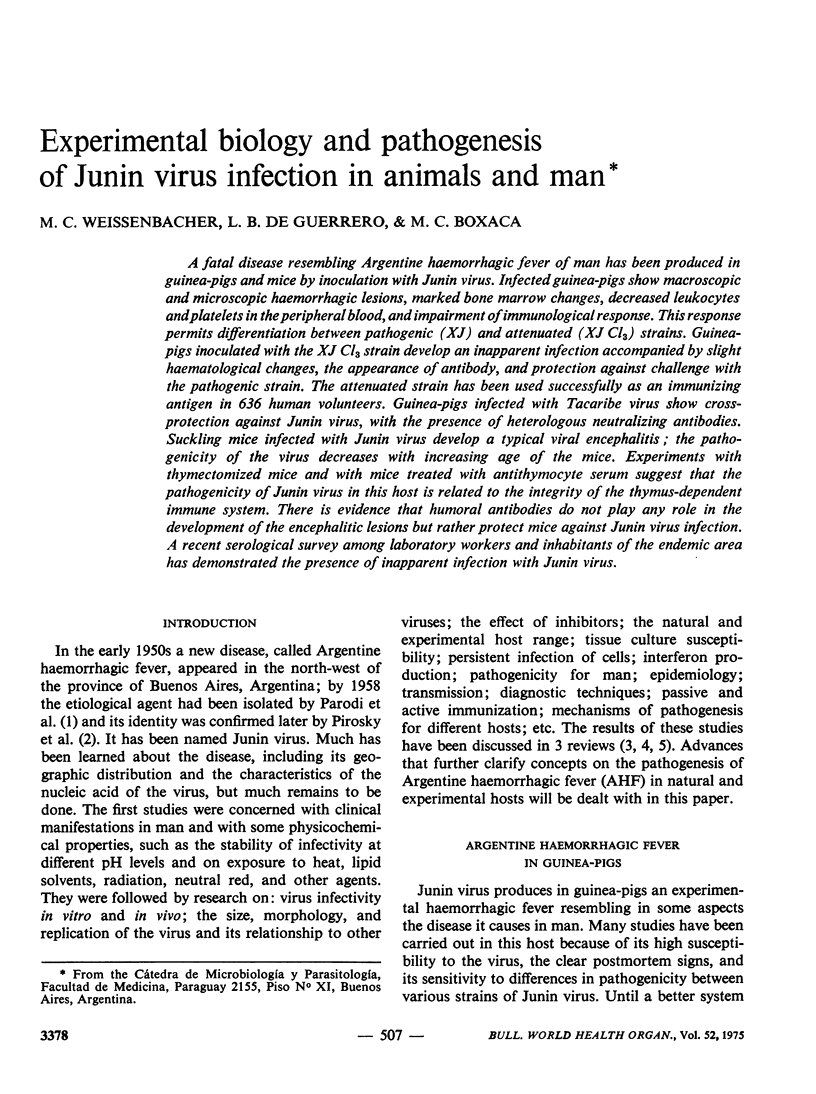
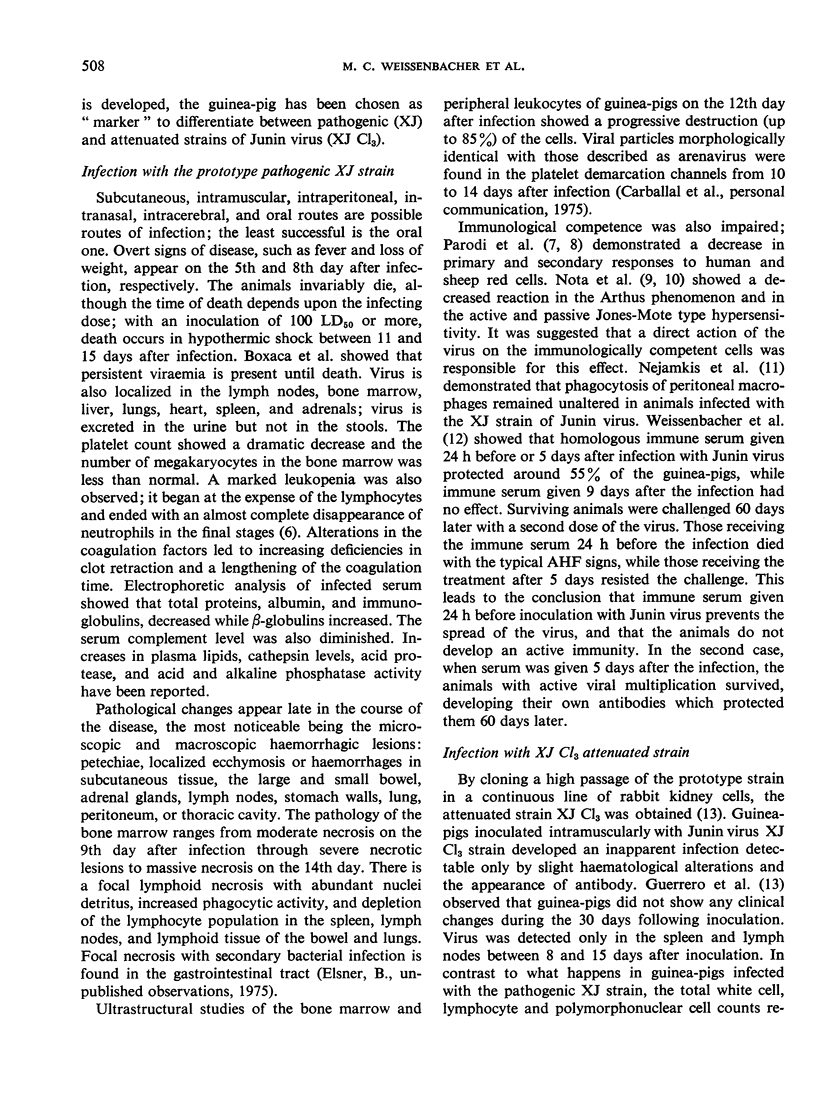
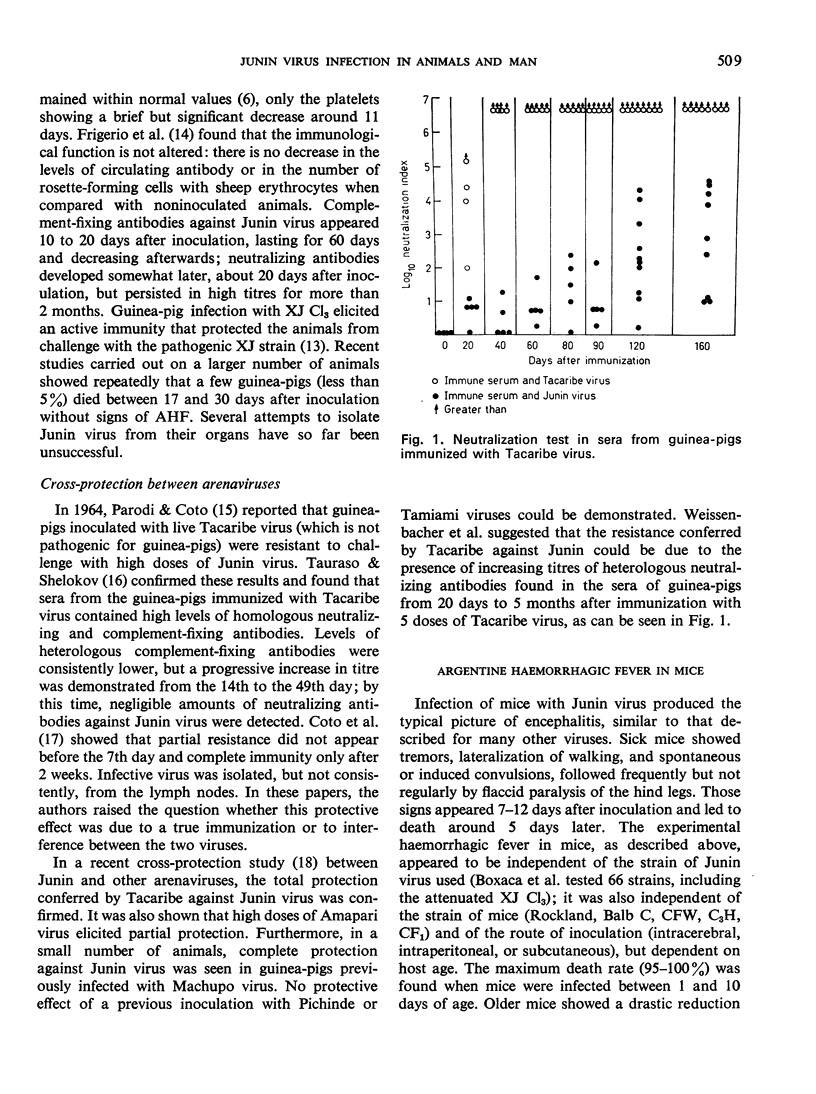
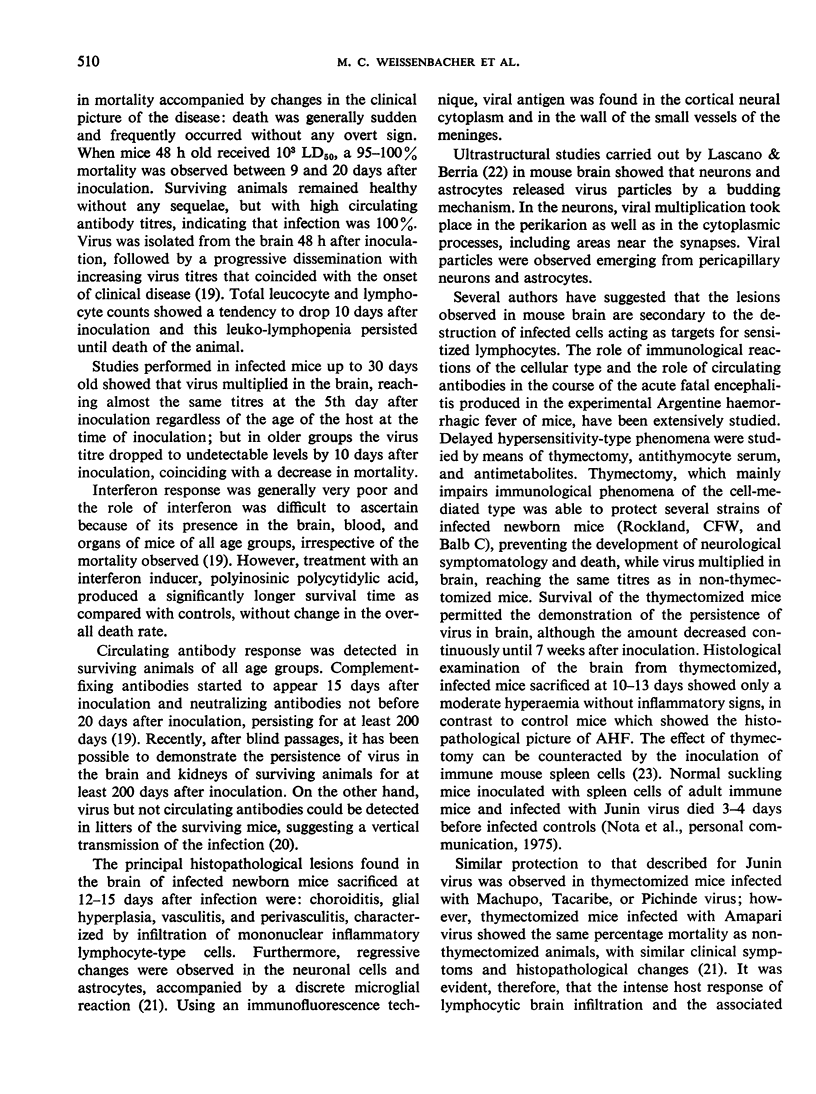
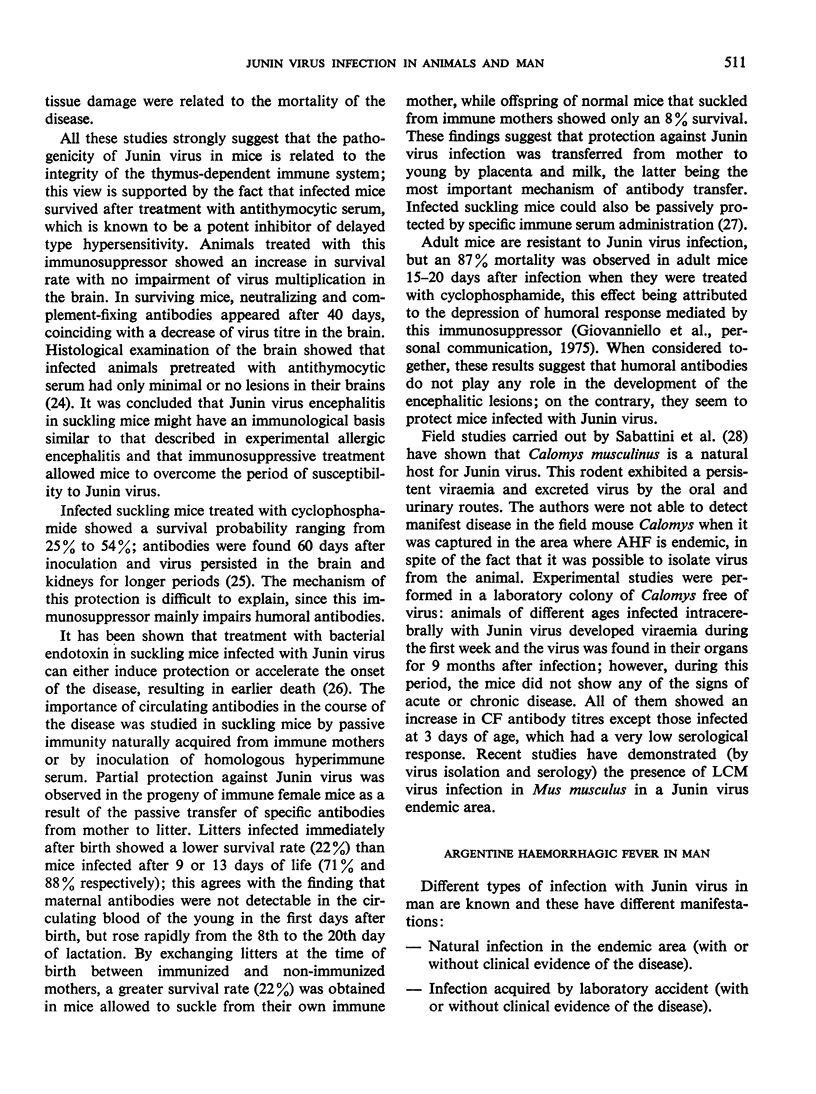
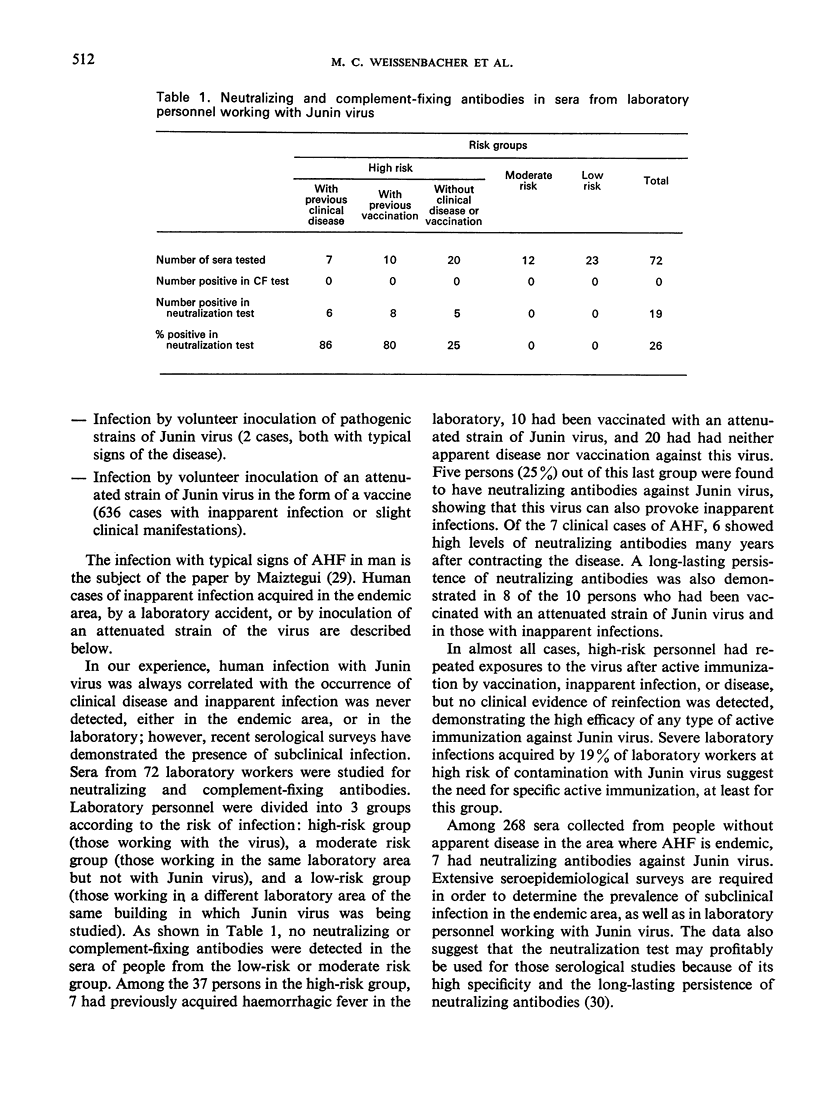
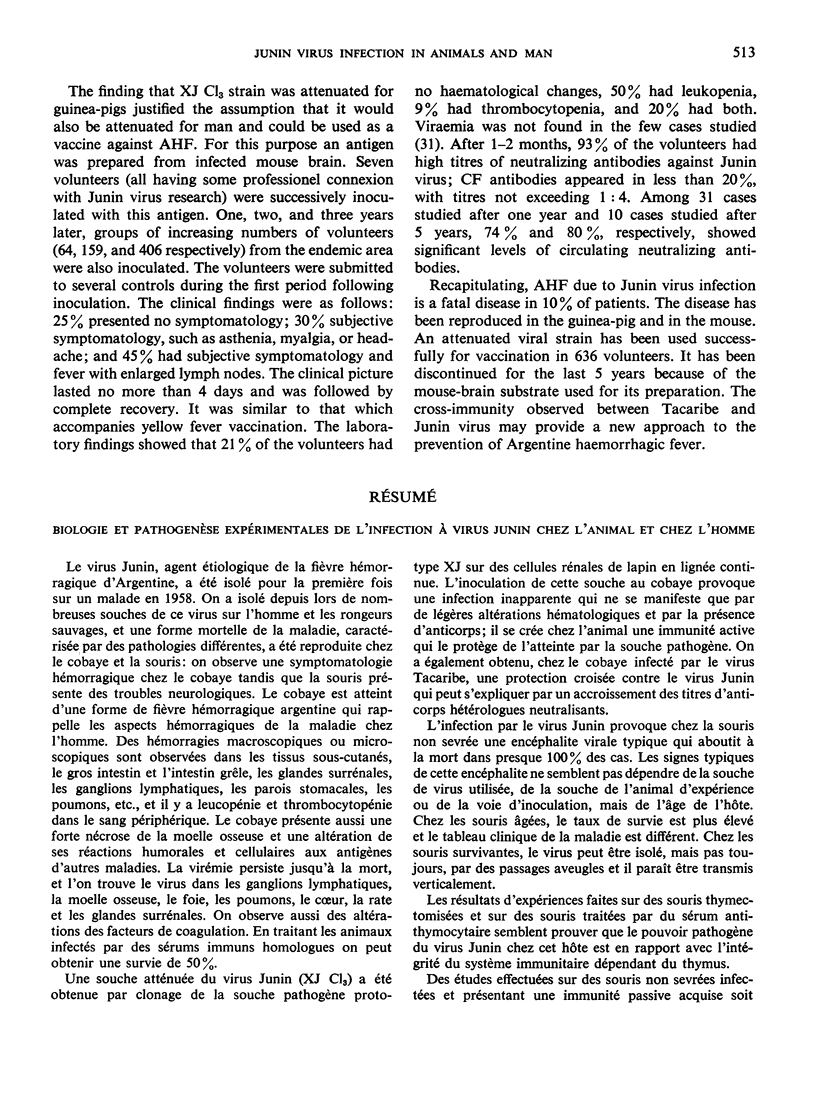
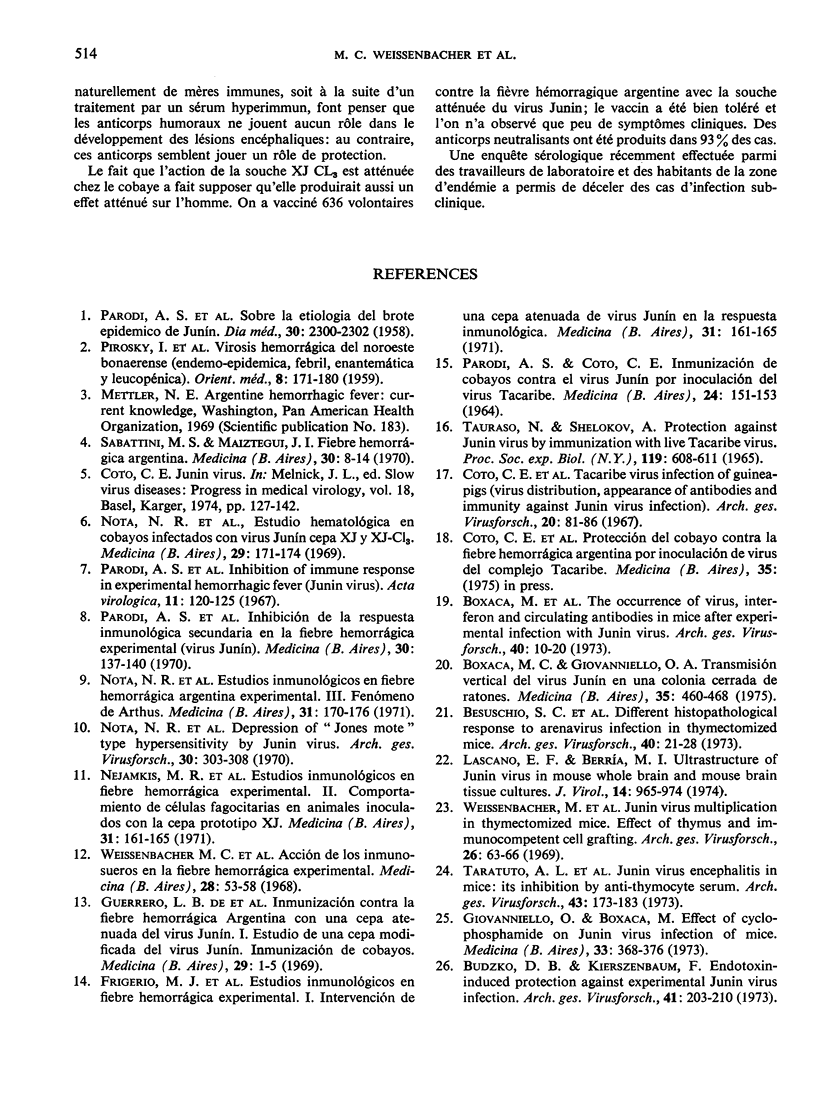
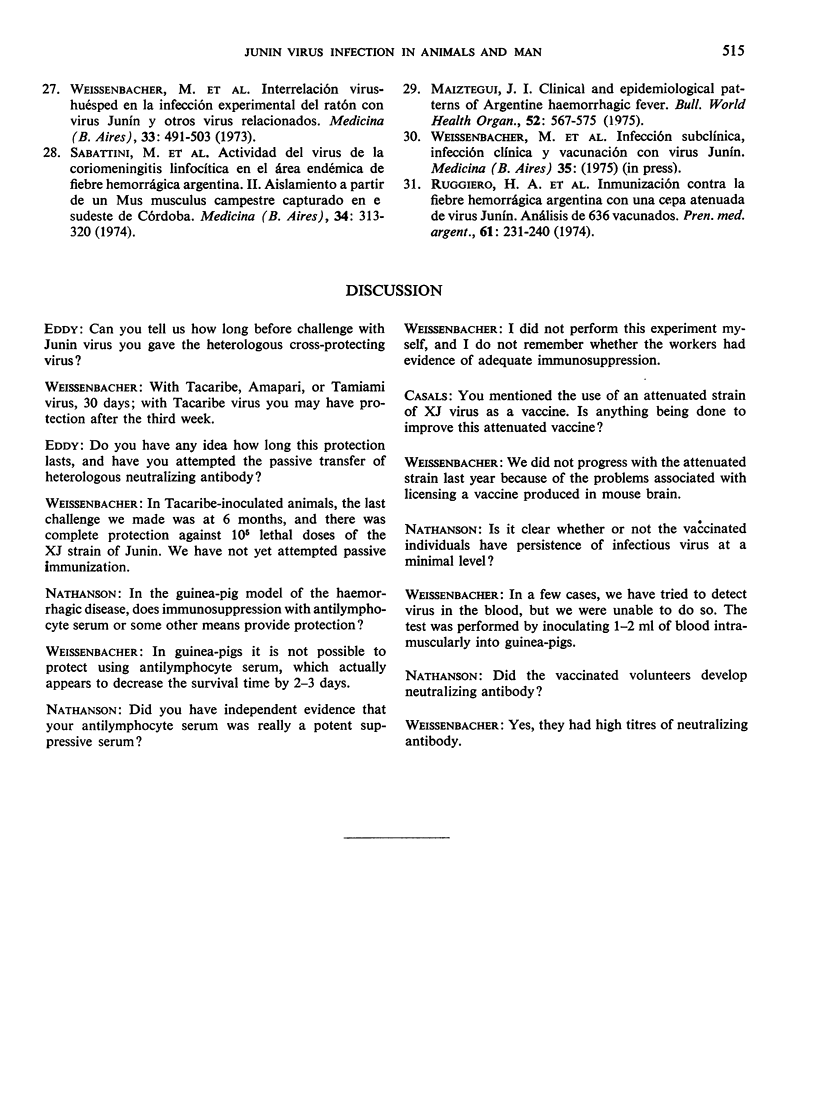
Selected References
These references are in PubMed. This may not be the complete list of references from this article.
- Besuschio S. C., Weissenbacher M. C., Schmuñis G. A. Different histopathological response to arenovirus infection in thymectomized mice. Arch Gesamte Virusforsch. 1973;40(1):21–28. doi: 10.1007/BF01242632. [DOI] [PubMed] [Google Scholar]
- Boxaca M. C., Giovanniello O. A. Transmisión vertical del virus Junín en una colonia cerrada de ratones. Medicina (B Aires) 1975 Sep-Oct;35(5):460–468. [PubMed] [Google Scholar]
- Boxaca M., de Guerrero L. B., Savy V. L. The occurrence of virus, interferon, and circulating antibodies in mice after experimental infection with Junin virus. Arch Gesamte Virusforsch. 1973;40(1):10–20. doi: 10.1007/BF01242631. [DOI] [PubMed] [Google Scholar]
- Budzko D. B., Kierszenbaum F. Endotoxin-induced protection against experimental Junín virus infection. Arch Gesamte Virusforsch. 1973;41(3):203–210. doi: 10.1007/BF01252767. [DOI] [PubMed] [Google Scholar]
- Coto C. E., Rey E., Parodi A. S. Tacaribe virus infection of guinea-pig. Virus distribution, appearance of antibodies and immunity against Junin virus infection. Arch Gesamte Virusforsch. 1967;20(1):81–86. doi: 10.1007/BF01245771. [DOI] [PubMed] [Google Scholar]
- Frigerio M. J., Nota N. R., Nejamkis M. R., Bisso G. M., De Guerrero L. B. Estudios inmunológicos en fiebre hemorrágica Argentina experimental. I. Intervención de una cepa atenuada del virus Junin en la respuesta immunológica. Medicina (B Aires) 1971 Jun;31(3):161–165. [PubMed] [Google Scholar]
- Frigerio M. J., Nota N. R., Nejamkis M. R., Bisso G. M., De Guerrero L. B. Estudios inmunológicos en fiebre hemorrágica Argentina experimental. I. Intervención de una cepa atenuada del virus Junin en la respuesta immunológica. Medicina (B Aires) 1971 Jun;31(3):161–165. [PubMed] [Google Scholar]
- Giovanniello O. A., Boxaca M. C. Effect of cyclophosphamide on Junin virus infection of mice. Medicina (B Aires) 1973 Jul-Aug;33(4):368–376. [PubMed] [Google Scholar]
- Lascano E. F., Berría M. I. Ultrastructure of Junín virus in mouse whole brain and mouse brain tissue cultures. J Virol. 1974 Oct;14(4):965–974. doi: 10.1128/jvi.14.4.965-974.1974. [DOI] [PMC free article] [PubMed] [Google Scholar]
- Maiztegui J. I. Clinical and epidemiological patterns of Argentine haemorrhagic fever. Bull World Health Organ. 1975;52(4-6):567–575. [PMC free article] [PubMed] [Google Scholar]
- Nota N. R., Frigerio M. J., Besuschio S. C., Nejamkis M. R., Bisso G. M. Estudios inmunológicos en fiebre hemorrágica Argentina experimental. 3. Fenómeno de Arthus. Medicina (B Aires) 1971 Jun;31(3):170–176. [PubMed] [Google Scholar]
- Nota N. R., Frigerio M. J., De Guerrero L. B., Nejamkis M. R. Depression of "Jones Mote" type hypersensitivity by Junin virus. Arch Gesamte Virusforsch. 1970;30(4):303–308. doi: 10.1007/BF01258360. [DOI] [PubMed] [Google Scholar]
- Nota N. R., Frigerio M. J., De Guerrero L. B., Nejamkis M. R. Estudio hematológico en cobayos infectados con virus Junin cepa XJ y cepa XJ clon 3. Medicina (B Aires) 1969 May-Jun;29(3):171–174. [PubMed] [Google Scholar]
- PARODI A. S., COTO C. E. INMUNIZACI'ON DE COBAYOS CONTRA EL VIRUS JUNIN POR INOCULACI'ON DEL VIRUS TACARIBE. Medicina (B Aires) 1964 May-Jun;24:151–153. [PubMed] [Google Scholar]
- PARODI A. S., GREENWAY D. J., RUGIERO H. R., FRIGERIO M., DE LA BARRERA J. M., METTLER N., GARZON F., BOXACA M., GUERRERO L., NOTA N. Sobre la etiología del brote epidémico de Junín. Dia Med. 1958 Sep 4;30(62):2300–2301. [PubMed] [Google Scholar]
- Parodi A. S., Frigerio M. J., Nota N. R., Nejamkis M. R., De Guerrero L. B., Bisso G. M. Inhibición de la respuesta inmunológica secundaria en la fiebre hemorragica experimental (virus Junin) Medicina (B Aires) 1970 Mar-Apr;30(2):137–140. [PubMed] [Google Scholar]
- TAURASO N., SHELOKOV A. PROTECTION AGAINST JUNIN VIRUS BY IMMUNIZATION WITH LIVE TACARIBE VIRUS. Proc Soc Exp Biol Med. 1965 Jul;119:608–611. doi: 10.3181/00379727-119-30251. [DOI] [PubMed] [Google Scholar]
- Taratuto A. L., Tkaczevski L. Z., Nota N. R., Nejamkis M. R., Giovanniello O. A. Junín virus encephalitis in mice: its inhibition by antithymocyte serum. Arch Gesamte Virusforsch. 1973;43(3):173–183. doi: 10.1007/BF01250412. [DOI] [PubMed] [Google Scholar]
- Weissenbacher M., De Guerrero L. B., Parodi A. S. Acción de los inmunosueros en la fiebre hemorrágica experimental. Medicina (B Aires) 1968 Mar-Apr;28(2):53–58. [PubMed] [Google Scholar]


